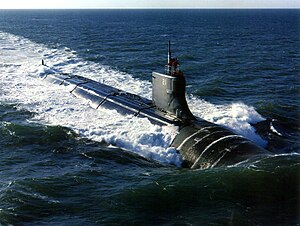
Back Seawolf-klas duikboot Afrikaans সিউল্ফ-শ্রেণির ডুবোজাহাজ Bengali/Bangla Třída Seawolf Czech Seawolf-klassen Danish Seawolf-Klasse German Clase Seawolf Spanish زیردریایی کلاس سیولف Persian Seawolf-luokka Finnish Classe Seawolf French צוללות התקיפה מסדרת זאב הים HE
   Top: USS Seawolf (SSN-21) underway
Middle: Seawolf subgroup (boats 1 and 2) profile Bottom: USS Jimmy Carter (boat 3) profile | |
| Class overview | |
|---|---|
| Builders | General Dynamics Electric Boat |
| Operators | |
| Preceded by | Los Angeles class |
| Succeeded by | Virginia class |
| Cost | $3 billion per unit (equivalent to $6 billion in 2023)[1] |
| Built | 1989–2005 |
| In commission | 1997–present |
| Planned | 29 |
| Completed | 3 |
| Cancelled | 26 |
| Active | 3 |
| General characteristics | |
| Type | Nuclear attack submarine |
| Displacement |
|
| Length |
|
| Beam | 40 ft (12 m) |
| Propulsion | |
| Speed | |
| Range | Unlimited |
| Endurance | Only limited by food supplies |
| Test depth | 1,600 ft (490 m)[6] |
| Complement | 140 |
| Crew | 14 officers; 126 enlisted |
| Armament | 8 × 26.5-inch torpedo tubes, sleeved for 21-inch weapons[7] (up to 50 Tomahawk land attack missile/Harpoon anti-ship missile/Mk 48 guided torpedo carried in torpedo room)[8] |
The Seawolf class is a class of nuclear-powered, fast attack submarines (SSN) in service with the United States Navy. The class was the intended successor to the Los Angeles class, and design work began in 1983.[10] A fleet of 29 submarines was to be built over a ten-year period, but that was reduced to 12 submarines. The end of the Cold War and budget constraints led to the cancellation of any further additions to the fleet in 1995, leaving the Seawolf class limited to just three boats. This, in turn, led to the design of the smaller Virginia class. The Seawolf class cost about $3 billion per unit ($3.5 billion for USS Jimmy Carter), making it the most expensive United States Navy fast attack submarine and second most expensive submarine ever, after the French Triomphant-class nuclear-powered ballistic missile submarines.
- ^ Trevithick, Joseph (22 October 2018). "Navy Wants New 'Seawolf-Like' Attack Submarines To Challenge Russian And Chinese Threats". Drive Media Inc. Retrieved 9 September 2019.
- ^ "The US Navy – Fact File". US Navy. Archived from the original on 3 July 2007. Retrieved 30 August 2008.
- ^ Alan Kuperman; Frank von Hippel (10 April 2020). "US study of reactor and fuel types to enable naval reactors to shift from HEU fuel". IPFM Blog.
- ^ a b "Validation of the Use of Low Enriched Uranium as a Replacement for Highly Enriched Uranium in US Submarine Reactors" (PDF). dspace.mit.edu. June 2015. p. 32. Retrieved 20 November 2021.
- ^ "S6W Advanced Fleet Reactor". www.globalsecurity.org. Retrieved 23 January 2023.
- ^ Federation of American Scientists (8 December 1998). "Run Silent, Run Deep". Military Analysis Network. Retrieved 10 May 2010.
- ^ Schank, John F.; Cesse, Cameron; Ip, Frank W.; Lacroix, Robert; Murphy, Mark V.; Arena, Kristy N.; Kamarck; Lee, Gordon T. (2011). "Learning from Experience: Volume II: Lessons from the U.S. Navy's Ohio, Seawolf, and Virginia Submarine Programs". rand.org.
- ^ "Attack Submarines - SSN". United States Navy Fact Files. United States Navy. Retrieved 13 November 2021.
- ^ a b "SSN Seawolf Class". naval-technology.com.
- ^ "Submarine Centennial Chronology". Archived from the original on 6 October 2012. Retrieved 22 December 2012.
© MMXXIII Rich X Search. We shall prevail. All rights reserved. Rich X Search